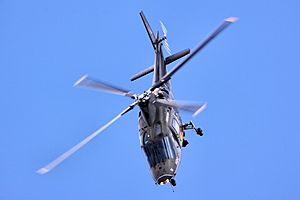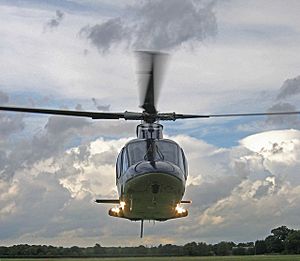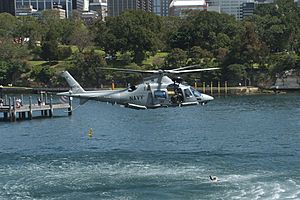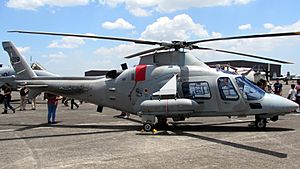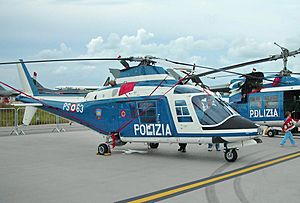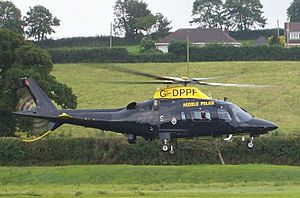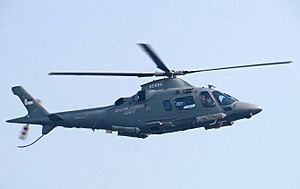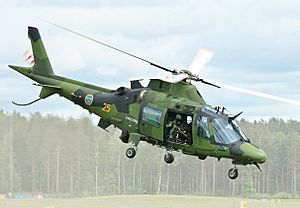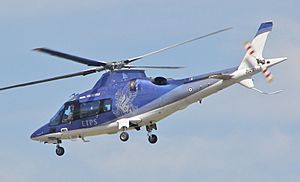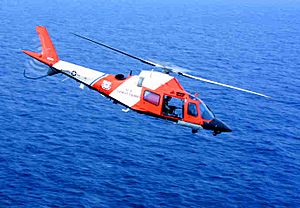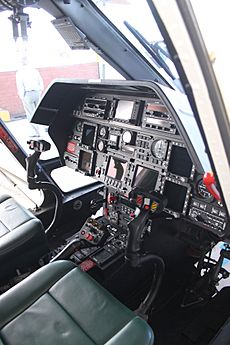AgustaWestland AW109 facts for kids
Quick facts for kids AW109 |
|
|---|---|
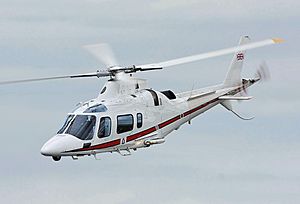 |
|
| An AW109E formerly operated by No. 32 Squadron RAF in 2012 | |
| Role | Search and rescue/utility helicopter |
| Manufacturer | Agusta AgustaWestland Leonardo S.p.A. |
| First flight | 4 August 1971 |
| Introduction | 1976 |
| Status | Active service, in production |
| Primary users | Italian Army Rega (Swiss Air Rescue) South African Air Force Royal New Zealand Air Force Royal Malaysian Air Force |
| Produced | 1971–present |
| Unit cost | US$ 6.3 million |
| Variants | AgustaWestland AW109S Grand |
| Developed into | AgustaWestland AW119 Koala |
The AgustaWestland AW109, first known as the Agusta A109, is a fast and light helicopter. It has two engines and can carry up to eight people. This helicopter was designed to do many different jobs. It was the first helicopter made entirely in Italy to be built in large numbers. Today, it is still made by Leonardo S.p.A., which used to be called AgustaWestland.
This helicopter was first planned in the late 1960s. It was meant for civilian use, like carrying people or cargo. Designers decided to give it two engines because customers preferred that. The first prototype helicopter flew on August 4, 1971. It was approved for use in 1975 and started flying for customers in 1976.
The AW109 is used for many tasks. These include carrying important people (VIPs), medical emergencies (like air ambulances), police work, and search and rescue missions. It is also used by many militaries around the world. Different versions have been made with new engines or bigger cabins. Some AW109s have an inside that can be changed quickly for different jobs.
When Agusta joined with the British company Westland Helicopters in 2000, the helicopter was renamed the AW109. Parts of the helicopter are made in Poland, and some are put together in China. The AW109 has been made for over 40 years! A similar helicopter, the AgustaWestland AW119 Koala, was developed from the AW109 but has only one engine.
Contents
- How the AW109 Helicopter Was Developed
- AW109 Helicopter Design Features
- AW109 Helicopter in Action
- Different Types of AW109 Helicopters
- Who Uses the AW109 Helicopter?
- AW109 Accidents
- AW109 Helicopters on Display
- Technical Details (AW109 Power with PW206C)
- Notable Appearances in Media
- See Also
- Images for kids
How the AW109 Helicopter Was Developed
Early Designs and First Flight
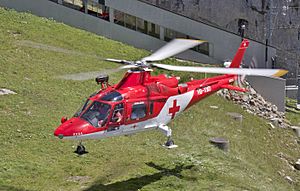
The idea for the AW109 started in the late 1960s at an Italian company called Agusta. They wanted to build their own helicopter for everyday uses. At first, they thought about a single-engine helicopter. But by 1969, they realized that people wanted a helicopter with two engines. So, they changed the design to include two Allison Model 250 engines.
The first test helicopter flew on August 4, 1971. It took almost four years to finish testing because they had to fix a problem with how it flew. The first helicopter for customers was ready in April 1975. In June 1975, it was approved to fly in North America.
Deliveries of the AW109 to customers began in 1976. This helicopter had some big advantages. It was faster, had two engines for safety, and could carry more people than other popular helicopters at the time. Agusta also started working on military versions of the A109. They tested it with missiles to see how it could be used in battles or on ships.
Newer Models and Global Production
After the first model, Agusta kept making improvements. In 1981, they offered the A109A Mk2 with a wider cabin. Later, in 1993, the A109 K2 was introduced with different engines. In 1996, the A109 Power came out, using yet another type of engine. By 2008, the A109 Power was used in 46 countries. A bigger version, the A109S Grand, was launched in 2006.
The helicopter's name changed to AW109 in 2000. This happened when Agusta merged with Westland Helicopters to form AgustaWestland. Since the mid-1990s, parts of the AW109 have been made by a Polish company called PZL-Świdnik. In 2004, AgustaWestland also teamed up with a Chinese company, Changhe Aircraft Industries Corporation. This partnership helps make and support the AW109 in China.
In 2014, AgustaWestland announced a new model called the AW109 Trekker. This version has skids instead of wheels for landing. It also has modern flight systems designed for one pilot to fly it. The Trekker is built to be even more useful for different jobs. It is put together in both the US and Italy.
AW109 Helicopter Design Features
The AW109 is a light helicopter known for its speed and sleek look. It is also easy to control. Over the years, many updates have added new flight systems and engine technology. AgustaWestland designed it to be useful for many different tasks and easy to maintain. It is very popular with VIPs and companies. In fact, about half of all AW109 Power helicopters are sold for VIP travel.
Other important jobs for the AW109 include emergency medical services, police work, and search and rescue. It is also used for missions at sea and by the military. In 2008, AgustaWestland said the AW109 was one of the best-selling helicopters in the world.
Different types of engines have been used in the AW109 models. These include the original Allison Model 250 engines, and newer ones like the Turbomeca Arriel and Pratt & Whitney Canada PW200 engines. Engines can be changed during major check-ups, which can improve how much the helicopter can lift. If one engine stops working, the AW109 is designed to still have enough power to fly safely on the other engine. The engines power a four-blade rotor system. Newer rotor blades are made from special materials to reduce noise and lower costs. The helicopter is known for performing well in hot weather and at high altitudes, even when carrying heavy loads.
The AW109 Power has advanced flight systems. These include an autopilot, a system to help with landing, and a GPS. It also has a moving map display, weather radar, and a system to warn about other aircraft. These systems make it easier for pilots to fly, even at night using night vision goggles. The AW109 can be flown by one or two pilots. All important systems, like the hydraulic and electrical systems, have backup parts. This makes the helicopter very safe. The AW109 also needs less maintenance because its parts are very reliable.
Some AW109 models have a "quick convertible interior." This means the inside of the cabin can be changed quickly. For example, seats can be removed to add medical stretchers. Special equipment can also be stored in a separate baggage area outside the cabin. The cabin can have features like air conditioning and soundproofing. Many AW109s have retractable wheels, which makes landing smoother and allows them to move on the ground. For use on ships, the landing gear is made stronger, and the helicopter has special protection against rust.
The AW109 can be fitted with extra equipment for different missions. This includes a hook for carrying cargo, skis for snow, and a system to protect against wires. It can also carry weapons like machine guns, cannons, rockets, and missiles. The US Coast Guard used their AW109s, called MH-68A, with rescue hoists, emergency floats, and searchlights. They also had machine guns and a powerful rifle.
AW109 Helicopter in Action
Many parts of the Italian military use the AW109. The Guardia di Finanza, which is Italy's financial police, has used its own version of the AW109 since the 1980s for border patrol.
During the Falklands War in 1982, the Argentine Army Aviation used three A109As in the Falkland Islands. They helped with scouting and moving people. One helicopter was destroyed, and the others were captured by the British. The British Army Air Corps then used these captured helicopters for special operations in the UK. The improved AW109E and SP versions have also been used by the Royal Air Force to fly members of the British Royal Family.
In 1988, 46 A109s were sold to the Belgian Armed Forces. Later, there were claims that Agusta had paid a large sum of money to secure this sale. This led to a scandal where a high-ranking official had to resign. Belgium has also had an A109 helicopter display team. In 2013, two Belgian AW109s helped with medical evacuations in Mali.

The South African Air Force (SAAF) ordered 30 AW109s in 1999. Most of these were put together in South Africa. Many SAAF AW109s were used for patrols and medical help during the 2010 FIFA World Cup. However, in 2013, many of these helicopters were not flying much due to a lack of money.
In 2001, the Swedish Armed Forces ordered 20 AW109s, calling them Hkp 15. These helicopters have been very busy, partly because other new helicopters were delayed. In 2015, two Swedish AW109s were used on a Dutch navy ship to fight piracy off the coast of Somalia. They worked perfectly for three months.
Between 2007 and 2012, the Royal Australian Navy used three AW109E Power helicopters to train its aircrew.
In 2008, the Royal New Zealand Air Force (RNZAF) ordered five AW109LUH helicopters. They use them for training and for general tasks. They have also been used for VIP missions.
In August 2008, two pilots, Scott Kasprowicz and Steve Sheik, broke the record for flying around the world in an AW109S Grand. They did it in just over 11 days. This helicopter is also known for being the fastest from New York to Los Angeles.
In 2013 and 2014, the Philippine Air Force (PAF) and the Philippine Navy ordered several AW109 Power helicopters. The PAF uses its AW109s as armed gunships. Both armed and unarmed AW109s are used by the Philippine Navy. During the Battle of Marawi, PAF AW109s were used in combat. In 2020, a PAF AW109 helped in an operation against kidnappers, firing at a boat.
Different Types of AW109 Helicopters
- A109A: The very first version made. It had two Allison Model 250 engines.
- A109A Mk.II: An improved version for civilian use.
- A109A Mk.II MAX: A version for medical emergencies, with a wider cabin and special doors.
- A109BA: Made for the Belgian Army. It had fixed landing gear and sliding doors.
- A109C: An eight-seat civilian version.
- A109E Power: An upgraded civilian version, with options for different powerful engines. It is also called AW109E.
- A109E Power Elite: A longer cabin version of the A109E Power. It has a modern "glass cockpit" with advanced navigation systems.
- A109LUH: A "Light Utility Helicopter" for military use. It is used by countries like South Africa, Sweden, and New Zealand.
- MH-68A: Eight A109E Power helicopters used by the United States Coast Guard for stopping illegal activities from 2000 to 2008. They were called "Mako" and later "Stingray."
- A109K2: Designed for flying in high places and hot weather. It has fixed wheels and is often used by police and rescue teams.
- A109S Grand: Also called the AW109 Grand, this is a civilian version with a longer cabin and more powerful engines.
- AW109 GrandNew: An updated version of the Grand, designed for single-pilot flying, especially for medical emergencies.
- AW109 Trekker: A version of the AW109S Grand that has fixed landing skids instead of wheels.
- CA109: A Chinese version of the AW109E, made by a joint company in China.
Who Uses the AW109 Helicopter?
The AW109 is used by many different groups, including private companies, military forces, emergency services, and air charter companies.
Military and Government Users
 Algeria Gendarmerie Nationale and Algerian police
Algeria Gendarmerie Nationale and Algerian police Albania Albanian Air Force
Albania Albanian Air Force Angola National Air Force of Angola
Angola National Air Force of Angola Bangladesh Bangladesh Navy
Bangladesh Bangladesh Navy
 Belgium Belgian Air Component
Belgium Belgian Air Component
 Bulgaria Bulgarian Border Police
Bulgaria Bulgarian Border Police Cameroon Cameroon Air Force
Cameroon Cameroon Air Force Chile Carabineros de Chile
Chile Carabineros de Chile Ecuador Bomberos Quito (Fire Department)
Ecuador Bomberos Quito (Fire Department) Egypt Egyptian Air Force
Egypt Egyptian Air Force Greece Hellenic Air Force
Greece Hellenic Air Force Italy Polizia di Stato (State Police), Carabinieri, Guardia di Finanza (Financial Guard), Italian Army, Vigili del Fuoco (Firefighters), State Forestry Corps
Italy Polizia di Stato (State Police), Carabinieri, Guardia di Finanza (Financial Guard), Italian Army, Vigili del Fuoco (Firefighters), State Forestry Corps Japan Tokyo Metropolitan Police
Japan Tokyo Metropolitan Police Latvia State Border Guard
Latvia State Border Guard Malaysia Malaysian Army
Malaysia Malaysian Army Mexico Mexican Air Force
Mexico Mexican Air Force New Zealand Royal New Zealand Air Force
New Zealand Royal New Zealand Air Force Nigeria Nigerian Air Force and Nigerian Navy
Nigeria Nigerian Air Force and Nigerian Navy Peru Peruvian Army
Peru Peruvian Army Philippines Philippine Air Force and Philippine Navy
Philippines Philippine Air Force and Philippine Navy Slovenia Slovenian Air Force, Slovenian Ministry of Defence, Slovenian Police
Slovenia Slovenian Air Force, Slovenian Ministry of Defence, Slovenian Police South Africa South African Air Force and Transnet National Ports Authority
South Africa South African Air Force and Transnet National Ports Authority Sweden Swedish Armed Forces
Sweden Swedish Armed Forces
 Turkmenistan Turkmen Air Force
Turkmenistan Turkmen Air Force Uganda Uganda National Police
Uganda Uganda National Police United Kingdom Royal Air Force
United Kingdom Royal Air Force
Past Military and Government Users
 Argentina Argentine Army (1979-2007)
Argentina Argentine Army (1979-2007) Australia Royal Australian Navy (2007-2012)
Australia Royal Australian Navy (2007-2012) Italy Italian Air Force
Italy Italian Air Force Paraguay Paraguayan Air Force
Paraguay Paraguayan Air Force Poland Air ambulances in Poland
Poland Air ambulances in Poland United Kingdom Army Air Corps
United Kingdom Army Air Corps
 Venezuela Venezuelan Army
Venezuela Venezuelan Army
AW109 Accidents
- On November 20, 2009, an AW109E Power used as an air ambulance in Poland crashed while landing.
- On January 16, 2013, an AW109 crashed in Vauxhall, London. It hit a construction crane before falling and catching fire. The pilot and one person on the ground died.
- On December 24, 2018, an AW109 crashed near Puebla, Mexico. The governor of Puebla and a former governor died in this accident.
- On June 10, 2019, an AW109E crashed on the roof of a building in New York City. The pilot died, and it caused a fire.
AW109 Helicopters on Display
- An A109A from the Italian Forest Service is on display inside Rome's zoo.
- An A109A is at the Fleet Air Arm Museum in Yeovil, England. This helicopter, named AE-331, was from the Argentine Army Aviation and was captured during the Falklands War.
Technical Details (AW109 Power with PW206C)
Data from ‘’Leonardo’’
General characteristics
- Crew: 1 or 2
- Capacity: 6 or 7 passengers
- Length: 11.448 m (37 ft 7 in) fuselage
- Height: 3.50 m (11 ft 6 in)
- Empty weight: 1,590 kg (3,505 lb)
- Max takeoff weight: 2,850 kg (6,283 lb)
- Powerplant: 2 × Pratt & Whitney Canada PW206C Turboshaft engine, 418 kW (561 hp) each
- Main rotor diameter: 11.00 m (36 ft 1 in)
Performance
- Maximum speed: 311 km/h (193 mph; 168 kn)
- Cruise speed: 285 km/h; 177 mph (154 kn)
- Never exceed speed: 311 km/h; 193 mph (168 kn)
- Ferry range: 932 km (579 mi; 503 nmi)
- Rate of climb: 9.8 m/s (1,930 ft/min)
Notable Appearances in Media
See Also
 In Spanish: AgustaWestland AW109 para niños
In Spanish: AgustaWestland AW109 para niños
- Aircraft related to this one
- AgustaWestland AW109S Grand
- Agusta A129 Mangusta
- AgustaWestland AW119 Koala
- Similar aircraft
- Bell 222/230
- Bell 427
- Bell 429 GlobalRanger
- Bell 430
- Eurocopter AS365 Dauphin
- Eurocopter EC135
- MD Helicopters MD Explorer
- Sikorsky S-76
- HAL Dhruv
- HAL Light Utility Helicopter
- Lists related to this aircraft
- List of rotorcraft
Images for kids


